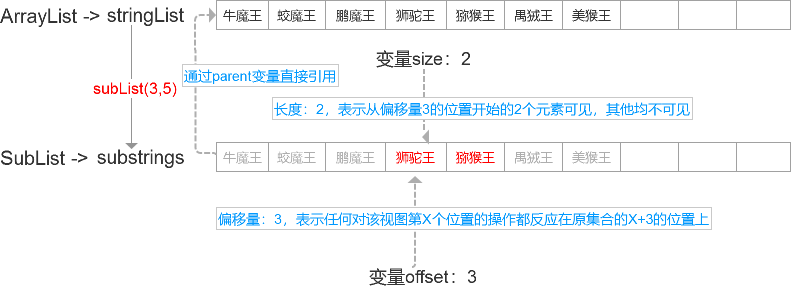再说Java集合,subList之于ArrayList
上一章说了很多ArrayList相关的内容,但还有一块儿内容没说到,那就是subList方法。先看一段代码
public static void testSubList() {
List<String> stringList = new ArrayList<>();
stringList.add("牛魔王");
stringList.add("蛟魔王");
stringList.add("鹏魔王");
stringList.add("狮驼王");
stringList.add("猕猴王");
stringList.add("禺贼王");
stringList.add("美猴王");
List<String> substrings = stringList.subList(3,5);
System.out.println(substrings.toString());
System.out.println(substrings.size());
substrings.set(1, "猪八戒");
System.out.println(substrings.toString());
System.out.println(stringList.toString());
}
看看执行结果如何?
[狮驼王, 猕猴王]
2
[狮驼王, 猪八戒]
[牛魔王, 蛟魔王, 鹏魔王, 狮驼王, 猪八戒, 禺贼王, 美猴王]
第一和第二的执行结果,非常容易理解,subList()方法作用就是截取集合stringList中一个范围内的元素。
第三和第四的执行结果都值得分析了,首先截取的字符串集合值为 [狮驼王, 猕猴王] ,但因为猕猴王在大雷音寺被美猴王打死了,我们用猪八戒来代替猕猴王;
因此我们通过substrings.set(1, "猪八戒"),将这个集合中第二个位置的值“猕猴王”设置为“猪八戒”,最终打印出来的结果也正是我们所预期的;但同时我们打印原集合stringList,发现其中的“猕猴王”也变成了“猪八戒”。这就比较奇怪了,两个问题:
1.我们操作的是截取后的集合,为什么原集合会变?
2.我们设置截取后某个位置(如第2个位置)的值,原集合改变的却不是对应位置的值?
一. subList原理初探
接下来我们带着问题寻找答案,我们看一下subList()的源码
/**
* Returns a view of the portion of this list between the specified
* {@code fromIndex}, inclusive, and {@code toIndex}, exclusive. (If
* {@code fromIndex} and {@code toIndex} are equal, the returned list is
* empty.) The returned list is backed by this list, so non-structural
* changes in the returned list are reflected in this list, and vice-versa.
* The returned list supports all of the optional list operations.
*
* <p>This method eliminates the need for explicit range operations (of
* the sort that commonly exist for arrays). Any operation that expects
* a list can be used as a range operation by passing a subList view
* instead of a whole list. For example, the following idiom
* removes a range of elements from a list:
* <pre>
* list.subList(from, to).clear();
* </pre>
* Similar idioms may be constructed for {@link #indexOf(Object)} and
* {@link #lastIndexOf(Object)}, and all of the algorithms in the
* {@link Collections} class can be applied to a subList.
*
* <p>The semantics of the list returned by this method become undefined if
* the backing list (i.e., this list) is <i>structurally modified</i> in
* any way other than via the returned list. (Structural modifications are
* those that change the size of this list, or otherwise perturb it in such
* a fashion that iterations in progress may yield incorrect results.)
*
* @throws IndexOutOfBoundsException {@inheritDoc}
* @throws IllegalArgumentException {@inheritDoc}
*/
public List<E> subList(int fromIndex, int toIndex) {
subListRangeCheck(fromIndex, toIndex, size);
return new SubList(this, 0, fromIndex, toIndex);
}
看注释,大概有以下几个意思
- 返回的是原集合在fromIndex和toIndex之间的元素的视图,虽然为视图,但支持集合的所有方法;
- 当fromIndex和toIndex相同时,返回空的视图;
- 任何对截取的视图的操作都会被原集合所取代;
看注释仅能知道我们例子最后的运行结果是正常的,但是对原理也还并不是特别清楚。我们继续看源码。
首先我们在例子中调用subList(3, 5)时,是new了一个SubList,这个SubList是ArrayList内部类,继承了AbstractList
private class SubList extends AbstractList<E> implements RandomAccess {
private final AbstractList<E> parent;
private final int parentOffset;
private final int offset;
int size;
SubList(AbstractList<E> parent, int offset, int fromIndex, int toIndex) {
this.parent = parent;
this.parentOffset = fromIndex;
this.offset = offset + fromIndex;
this.size = toIndex - fromIndex;
this.modCount = ArrayList.this.modCount;
}
}
从这个内部类的源码中,我们可以看到:
- SubList并没有像ArrayList一样定义Object[]来存放数据,而定义了一个变量parent来保存传递的原集合;
- 定义了一个offset用于保存进行偏移量,当对SubList修改时,就可以通过偏移量找到parent中对应的位置;
- 定义了size用来表示我们在parent集合中可见范围是多少;

有了上面的说明,其实SubList的原理已经很清晰了,接下来,我们用SubList中常用的方法来印证一下。
二. add(E e)方法
substrings.add("九头蛇");
System.out.println(substrings.toString());
System.out.println(stringList.toString());
接着上面的例子,在substrings中添加“九头蛇”,按照规则,add()方法添加元素会在集合的最后,也就是说substrings的第3个位置(下标为2),对应parent原集合的位置下标就是2+3=5,会在stringList第六个位置插入“九头蛇”。看一下输出的结果
[狮驼王, 猪八戒, 九头蛇]
[牛魔王, 蛟魔王, 鹏魔王, 狮驼王, 猪八戒, 九头蛇, 禺贼王, 美猴王]
可以看到结果的确如此,那么我们在看一下add(E e),在SubList这个内部类里面并没有发现该方法,因此我去父类中找。
在AbstractList中找到了
public boolean add(E e) {
add(size(), e);
return true;
}
接下来,我们在SubList中找到了实现方法
public void add(int index, E e) {
rangeCheckForAdd(index);
checkForComodification();
parent.add(parentOffset + index, e);
this.modCount = parent.modCount;
this.size++;
}
很明显,源代码和我们开始的分析是一致的,当然在添加之间需要进行空间容量判断,是否足以添加新的元素,扩容规则,我们上一章已经讲过。
三. 其他方法
关于SubList的其他方法,其实和add原理一样,不论是set(int index, E e),get(int index),addAll(Collection<? extends E> c),remove(int index),都是先判断当前传入的位置索引是否正确(如是否大于size,小于0等),再根据规则计算出原集合中的位置下标,最终完成对集合的操作。
四. 总结
本文续接上一章ArrayList原理及使用,对ArrayList中的常用方法subList进行了剖析,从源码的角度对通过subList方法得到的集合和原集合有何关系,有何不同点,从而避免工作中遇到各种坑,若有不对之处,请批评指正,望共同进步,谢谢!
再说Java集合,subList之于ArrayList的更多相关文章
- Java 集合系列03之 ArrayList详细介绍(源码解析)和使用示例
概要 上一章,我们学习了Collection的架构.这一章开始,我们对Collection的具体实现类进行讲解:首先,讲解List,而List中ArrayList又最为常用.因此,本章我们讲解Arra ...
- Java 集合:HashSet 与 ArrayList
Set 集合是无序不可以重复的的.List 集合是有序可以重复的. Java 集合:HashSet 与 hashCode.equals 博客里面已经说到这个问题,但是解释的还是不够清楚. 看一个小例子 ...
- java集合的实现细节--ArrayList和LinkedList
ArrayList和LinkedList的实现差异 List代表一种线性表的数据结构,ArrayList则是一种顺序存储的线性表,ArrayList底层采用动态数组的形式保存每一个集合元素,Link ...
- 【Java集合源代码剖析】ArrayList源代码剖析
版权声明:本文为博主原创文章,未经博主同意不得转载. https://blog.csdn.net/mmc_maodun/article/details/35568011 转载请注明出处:http:// ...
- Java集合系列(二):ArrayList、LinkedList、Vector的使用方法及区别
本篇博客主要讲解List接口的三个实现类ArrayList.LinkedList.Vector的使用方法以及三者之间的区别. 1. ArrayList使用 ArrayList是List接口最常用的实现 ...
- Java集合源码剖析——ArrayList源码剖析
ArrayList简介 ArrayList是基于数组实现的,是一个动态数组,其容量能自动增长,类似于C语言中的动态申请内存,动态增长内存. ArrayList不是线程安全的,只能用在单线程环境下,多线 ...
- 【Java集合】试读ArrayList源码
ArrayList简介 ArrayList 是一个数组队列,相当于 动态数组.与Java中的数组相比,它的容量能动态增长.它继承于AbstractList,实现了List, RandomAccess, ...
- Java 集合系列03之 ArrayList详细介绍
ArrayList做为List接口中最常用的实现类,必须掌握. 一.ArrayList简介 与Java中的数组相比ArrayList的容量可以动态增加.它继承与AbstractList,实现了List ...
- Java集合【8】-- ArrayList源码分析
目录 1. ArrayList 1.1 ArrayList特点介绍 1.2 实现的接口和继承的类 2. 成员变量 3. 构造方法 4. 常用增删改查方法 添加元素 查询元素 更新元素 删除元素 5.自 ...
- 【转】Java 集合系列03之 ArrayList详细介绍(源码解析)和使用示例
原文网址:http://www.cnblogs.com/skywang12345/p/3308556.html 上一章,我们学习了Collection的架构.这一章开始,我们对Collection的具 ...
随机推荐
- [LeetCode]Word Break 特里
意甲冠军:推断字符串给定的字符串是否构成词典. 来推断目标字符串相匹配整个字典.我们需要来推断目标字符串的每个前缀开始的下一场比赛,这需要匹配目标字符串的成功,所有前缀的枚举. class TrieN ...
- Verilog分频器
verilog设计进阶 时间:2014年5月6日星期二 主要收获: 1.自己动手写了第一个verilog程序. 题目: 利用10M的时钟,设计一个单周期形状例如以下的周期波形. 思考: 最開始的想法是 ...
- 从编译,执行过程理解c#
上节我们说过C#所开发的程序源代码并不是编译成能够直接在操作系统上执行的二进制代码.与Java类似,它被编译成为中间代码,然后通过.NET Framework的虚拟机——被称之为通用语言运行时(CLR ...
- TCP 报文段结构
源端口.目标端口:计算机上的进程要和其他进程通信是要通过计算机端口的,而一个计算机端口某个时刻只能被一个进程占用,所以通过指定源端口和目标端口,就可以知道是哪两个进程需要通信.源端口.目标端口是用 ...
- UWP 扩展/自定义标题栏的方法,一些概念和一些注意事项
原文 UWP 扩展/自定义标题栏的方法,一些概念和一些注意事项 在 Windows 10 的前几个版本中将页面内容扩展到标题栏上还算简单,主要是没什么坑.直到一些新控件的引入和一些外观设计趋势变化之后 ...
- 使用 Microsoft.UI.Xaml 解决 UWP 控件和对老版本 Windows 10 的兼容性问题
原文 使用 Microsoft.UI.Xaml 解决 UWP 控件和对老版本 Windows 10 的兼容性问题 虽然微软宣称 Windows 10 将是最后一个 Windows 版本,但由于年代跨越 ...
- 对std::string和std::wstring区别的解释,807个赞同,有例子
807down vote string? wstring? std::string is a basic_string templated on a char, and std::wstring on ...
- NetCore使用Jwtbearer给WebAPI添加访问控制
原文:NetCore使用Jwtbearer给WebAPI添加访问控制 现在JWT代替session来做访问控制已经成为大部分webapi的做法,今天我们也来尝试一下 WebAPI使用NetCore2. ...
- MSRA专访摘要
前段时间有幸参加微软亚洲研究院之旅,顺便投简历,没想到在两次访谈迎来,并且是连续 的两次被拒绝.严重的刺激到了我.导致我疯狂的复习刷Offer.如今最终算是告于段落.如今也最终有空沉下心来总结 总结近 ...
- 自定义 DependencyProperty 与 RoutedEvent
原文:自定义 DependencyProperty 与 RoutedEvent //自定义依赖属性 class MyBook : DependencyObject//依赖属性必须派生自Dependen ...
